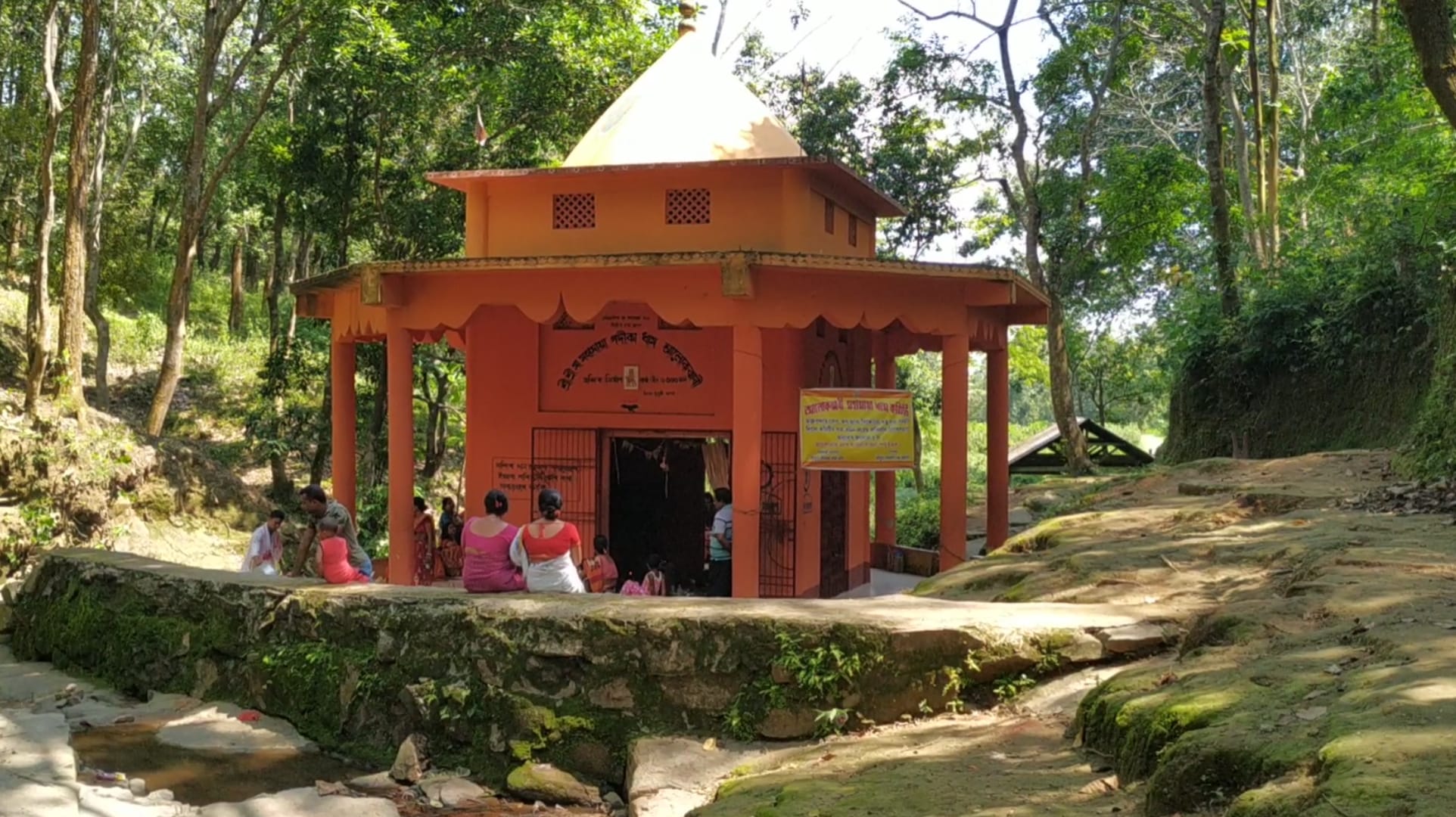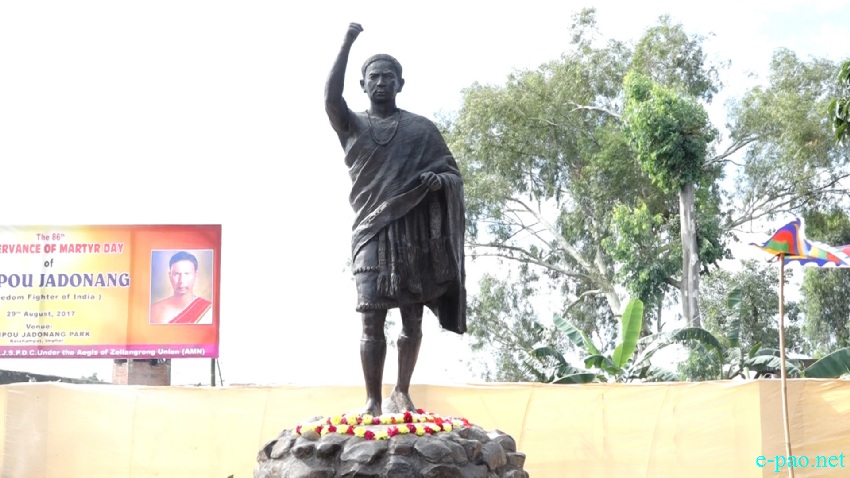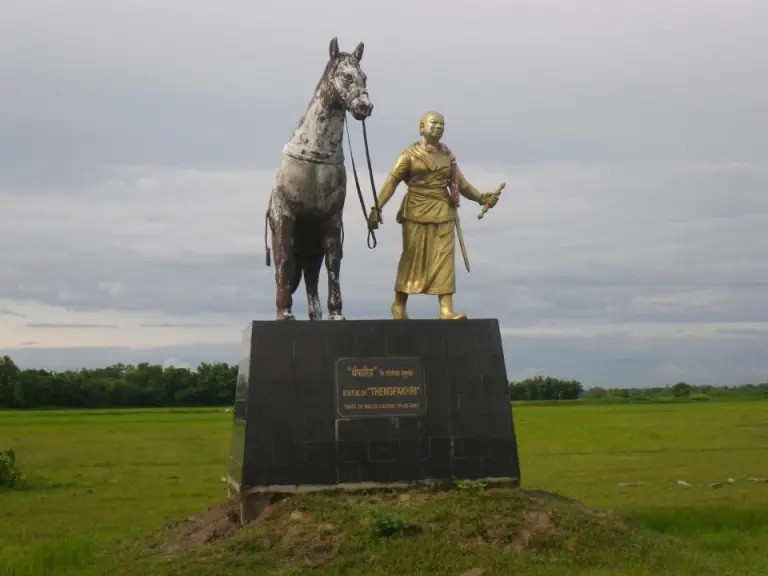By Dr Surajit Ray
“Nil Parboto Bashini
Bordey Devi Byaghro Bahana
Mahamaya Debboi Namah.”
Visiting sacred places to pay their obeisance is a traditional religious practice among the people of all religions. Since time immemorial, people have made long distance travels to visit their important places of worship. There are some places people desire to visit at least once during their lifetime. It is a fact that visiting sacred places makes one’s heart and soul, mind and body refreshingly peaceful and purified. A troubled-torn heart gets its ultimate solace and peace after visiting such places, which is hard to find anywhere else. It is also observed that while all humanly possible ways and means fail, people finally tend to believe in almighty God and pray to Him seeking His blessing and grace in their hours of crisis.
Nobody can, perhaps, deny that visiting sacred places has its value that makes the dispirited spirited, the hopeless hopeful and the inactive active. Going on a pilgrimage certainly not only cleanses our sins and ills, but also solidifies and intensifies our national and religious integration. Our sacred places are not only the places of worship, but also the places of understanding and sharing with others thus widening the circle of brotherhood, love, and trust.
The Alokjhari Shakti Peeth of goddess Mahamaya (popularly known as Alokjhari Dham; henceforth it’s used interchangeably) is regarded as one of the greatest Shakti Peethas for the Hindu pilgrims in lower Assam. In terms of attractions, this Peeth is situated amidst a forest maintaining the same puja practices like that of Maa Mahamaya Temple of Bogribari and Maa Kamakhya Temple of Nilachal in Guwahati.
The goddess Mahamaya has traditionally been worshipped by the local people of Alokjhari and its adjoining villages to avert the attack of tigers on the domestic animals and human beings. It’s still a common practice among the Hindu people residing in the villages near the Alokjhari forest to offer pujas to Maa Mahamaya first with newly harvested rice before they consume the same. Goddess Mahamaya was also the presiding deity of the then Zamindar (landlord) of Gauripur. Later, the goddess received wide acceptances and these days, all Hindus of lower Assam and North Bengal worship Maa Mahamaya with reverence.
The Peeth, located on the periphery of Dhubri district bordering Kokrajhar district (BTAD) in the village Alokjhari part II, is 310 kilometres in the far west of Guwahati.
Before delving into the mythological and historical details of this Peeth, it would be worthwhile and relevant to trace the meaning of the place Alokjhari. Etymogically, the word Alokjhari is derived from two words: Alok and Jhari. While Alok means light (jyoti) and Jhari means forest (jungle). In the midst of the Alokjhari forest, there has been a highest peak, which is known as Shivor Tilla (peak of Lord Shiva). It is believed that, once Lord Shiva used to sit in meditation on this highest peak and bright lights emanated from his head that illuminated the whole of the forest. It needs to be mentioned here that the place of Alokjhari Shakti Peeth, also known as Sati Dham (temple of goddess Parvati), has been referred to as a sacred place as per the Joginitantra and the Kalika Puran.
As the mythology goes, king Dakhya, the son of Brahma once organised a Jogya (a religious congregation) in the capital of Kankhal of his kingdom. However, Dakhya did not invite his daughter and her husband, Shiva to the Jogya. Having leant from others about the arrangement of Jogya at her father’s home, Sati Parvati insisted her husband on attending the Jogya. In spite of her husband’s objection, she attended the same. She realised that she did not get any importance and care from her father at the Jogya. Besides, she had to bear with the abuse of her husband from her father in his absence. King Dakhya insulted Shiva at the Jogyabhumi in presence of all the saints and munis. Sati Parvati became saddened. Being exhausted of bearing all blames, she finally committed suicide on the spot of Jogyabhumi. Hearing this shocking news, Lord Shiva became furious and created strong Birbhadra from his head and ordered him to destroy the Jogyabhumi and killed the king Dakhya on the spot. Later, Lord Shiva took the dead body of the Sati on his shoulders and started dancing throughout Bharat that caused widespread destruction to the creation of God. Feeling apprehensive about the whole of the creation, Lord Bishnu, in a bid to pacify Shiva, thought out a plan to cut the dead body of the Sati into pieces with his chakra. The body parts of the Sati dropped at 51 different places in Bharat, and thus those 51 places later grew up as Shakti Peethas for the Hindus.
It is believed that the paduka (a pair of feet) of Sati Parvati dropped here at Alokjhari, which later turned into one of the Shakti Peethas. As a testimony, there has been an altar of worship in the midst of the Alokjhari forest, where the paduka of Maa Mahamaya is still inscribed on a plate of stone.
It is said that the Dham has been maintaining its existence through the times from Narakasur to Bhagadatta, from Shalstambha to Niladhaj and the Koch king Naranarayana. It is a fact that Naranarayana, the learned king of Kamatapur, was the latest devoted patron of the deity Mahamaya of Alokjhari. However, in the colonial period during the times of Governor General of India, Lord Cornwallis, the system of administration was amended and therefore, power was decentralised to the Zamindary system (a local form of governance) from where tax and revenues were collected. From that time onwards, the management of the Alokjahri Dham came under the direct control of the Zamindar (landlord) of Gauripur in the erstwhile undivided district of Goalpara.
As far as the historical dimension of this Peeth is concerned, there has been a supernatural event connected with this Peeth. It is about 500 years ago in the Ghulla Paragana under the then undivided Goalpara district in pre-independence period, the Zamindar Protap Chandra Baruah saw a dream in his sleep. He dreamt that a saint named Sachidananda had been waiting for him keeping the golden idol of goddess Mahamaya on the altar, to be offered to the Zamindar. Having had the dream, the Zamindar made vigorous attempts two times searching for the saint and the idol with a huge contingent of elephants and men. But he failed in his every attempt. However, he succeeded in his third attempt in finding out the saint and the idol in the dense forest of Alokjhari. The Zamindar was surprised to see that the saint, who looked larger in size and shape, was sitting in meditation with his strangely long and big lump of hair by the side of the altar of worship of goddess Mahamaya, keeping the golden idol in a golden singhasan. The Zamindar, being overwhelmed by the sight of the saint, prostrated before him and paid his obeisance to the saint. He later disclosed everything to the saint about his dream and purpose of his visit to that place. But the saint did not move at his prayer of handing over the idol and even told the Zamindar that he was in no mood to give it to the Zamindar. The Zamindar did not leave the place easily and prayed persistently to get the idol. Being pleased with the Zamindar’s fervent and unceasing prayer, the saint ultimately softened his mind and agreed to his prayer on conditions. The saint advised the Zamindar to construct a temple of Maa Mahamaya in which to place the idol and to offer puja to it every day with sanctity of mind. He agreed to abide by the advice. Hereafter, the saint told him to pray by prostrating on the ground and then all of a sudden, he lashed out at the Zamindar with his foot five times. Further, the saint warned him saying that the golden idol of goddess Mahamaya would remain in his royal family only for five generations, and thereafter it would leave the royal family and go somewhere else. After saying this, the saint, Sachidananda, suddenly disappeared from the scene.
Since time immemorial, daily puja is offered at the Dham, located in the forest of Alokjhari. The priests have to negotiate the zigzag hilly road on foot to reach the Dham to offer puja. They carry fruits, milk, unboiled rice, banana leaf, sweets, red sandal wood, vermillion, and other puja materials in a busket to the Dham. The priests offer puja at 10 o’clock in the morning every day. As the Dham is situated in a hilly terrain, there is no use of motor vehicles to reach there. While going to and coming from the Dham after offering puja, the priests make sounds and chant the name of Maa Mahamaya whenever and wherever they see tigers on the forest roads. Surprisingly, the tigers leave their way to the priests and enter the forest. It’s also surprising to note that there has been no incident of tiger-priests conflicts so far in the Alokjhari forests.
It’s to be mentioned here that there had been some cave-like stone houses for the tigers near the Dham, which are known as tiger house. It is said that, the first sacrifice of he-goat offered to goddess Mahamaya on the last day of the month of Chot or Chaitra, used to be placed in front of one of the tiger houses. The tiger later dragged the sacrificed goat into the cave for consumption. The tiger houses were later damaged due to natural calamities such as earthquake, land slide, and erosion. This apart, there had been a pair of black crows that centred round the Dham. The stone plate on which food was offered to the crows is today known as kak Shilla, which is still visible by the side of the Paduka Dham
There has been a snann ghat (bathing place) two kilometres on the north of the Dham, which is today known as Thakuranir Ghat (bathing place of goddess Mahamaya). This ghat is characterised by continuous water fall from the high hills of Alokjhari. It’s believed that after taking bath at this ghat, goddess Mahamaya used to play Baroguti (crossword) with her friends. However, on being interviewed about the significance of the Dham, Shri Shibashish Chakraborty, a school teacher of village of Kachakhana, reports to the author of this article that he himself observed the lines drawn on the earth on which goddess Mahamaya had played crossword with her friends. The drawn lines are still visible at a little distance from the Dham, which is known today as “pat angina” (temple courtyard). Apart from this, there has been a well by the side of the Dham, which was dug by penetrating into the hilly boulders. However, there is no exact data as to when and who set up the well. The water of this well is believed to be holy and if drunk, it cures people of their diseases and problems and fulfils their dreams and prayers. It’s a common belief among the devotees that those who pray sincerely by touching the shindook stone lying near the Dham, achieve wealth and much more. Besides, there have been several brooks (locally called Jhora) flowing from the Alokjhari forest of which five are remarkable. They are: Thakuranir Jhora, Talowa Jhora, Masha Jhora, Bhaluk Jhora, and Boistom Jhora. It’s believed that blending of water of these five brooks together has a supernatural value. People drink the blended holy water of these five brooks believing that it cures them of incurable diseases and relieves them of pain. Hence, people preserve such holy water for future use as well.
As far as the attraction of this Dham is concerned, thousands of devotees visit this Shakti Peeth annually with a lot of hope and optimism. It’s believed that those who worship and pray to the Paduka of goddess Mahamaya sincerely and earnestly are blessed with fulfilment of their wishes. Even issueless parents are said to have been fortunate by being blessed with children.
This Dham, however, has a peculiar characteristic. There was no concrete structure of temple on the Dham premises. It has been situated amidst the forest under the open sky. Several attempts were previously made by the then Zamindars of Gauripur to build a concrete temple for goddess Mahamaya, but all their attempts ended in smoke. Hence, it’s believed that goddess Mahamaya does not wish herself to be confined to a particular concrete temple. However, a concrete temple was constructed a few years ago over the paduka of Maa Mahamaya.
As far as the time and occasion of visit to this Dham is concerned, thousands of devotees visit this Peeth seeking bliss of Maa Mahamaya on the particular days of the year. Besides the daily puja, annual grand puja starts from the last week of Chot or Chaitra up to the end of the first week of Bohag or Boishag of the Assamese calendar (approximately in the 2nd and 3rd week of April). Along with the puja, a grand mela (fair) also starts at the foothills opposite to the Dham and continues for a week from 6th to 12th of Bohag. Hence, it’s popularly called Sath Beshmar Mela.
Way of worship of Maa Mahamaya is similar to that of Maa Mahamaya of Bogribari and Maa Kamakhya of Nilachal in Guwahati. While daily puja is offered with fruits, milk, sweets, dai-chira(flattened rice and curd), etc. the annual puja is offered with the sacrifices of he-goats and pigeons. On fulfilment of their wishes and prayers, the devotees generously offer puja with sacrifices of animals. Maa Mahamaya is worshipped by the Hindus such as the Koch Rajbangshis, Bengalis, Baro Kacharies, Rabhas, etc. with animal sacrifices. The majority of the worshippers are the Koch Rajbangshis.
On the foothills of Alokjhari, several cow boys are seen grazing their cattle. While sweet music floats from their flute playing the melodious song: “tomora gaile ki ashiben/mor mahut bandhu re”, everyone with fondness remembers Protima Baruah Pandey, the queen of Goalpariya folksong, whose father and fore fathers had been the devoted patrons of the goddess Maa Mahamaya.
References:
A Souvenir on Alokjhari Maa Mahamaya (2002), written by Shri Bhabani Charan Ray & published by Shanteswar Adhikary, Alokjhari (Dhubri, Assam)
Written inputs on Alokjhari Maa Mahamaya Dham from Shri Radha Ballav Adhikary, Kachakhana (Dhubri, Assam)
(The author of this article is Assistant Professor and Head, Department of English, Pandit Deendayal Upadhyaya Adarsha Mahavidyalaya, Eraligool, Karimganj. He can be reached at Mobile No. 9101792014)






